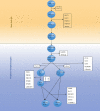B- and T-Cell Subset Abnormalities in Monogenic Common Variable Immunodeficiency
- PMID: 35784324
- PMCID: PMC9241517
- DOI: 10.3389/fimmu.2022.912826
B- and T-Cell Subset Abnormalities in Monogenic Common Variable Immunodeficiency
Abstract
Common variable immunodeficiency (CVID) is a heterogeneous group of inborn errors of immunity characterized by reduced serum concentrations of different immunoglobulin isotypes. CVID is the most prevalent symptomatic antibody deficiency with a broad range of infectious and non-infectious clinical manifestations. Various genetic and immunological defects are known to be involved in the pathogenesis of CVID. Monogenic defects account for the pathogenesis of about 20-50% of CVID patients, while a variety of cases do not have a defined genetic background. Deficiencies in molecules of B cell receptor signaling or other pathways involving B-cell development, activation, and proliferation could be associated with monogenetic defects of CVID. Genetic defects damping different B cell developmental stages can alter B- and even other lymphocytes' differentiation and might be involved in the clinical and immunologic presentations of the disorder. Reports concerning T and B cell abnormalities have been published in CVID patients, but such comprehensive data on monogenic CVID patients is few and no review article exists to describe the abrogation of lymphocyte subsets in these disorders. Hence, we aimed to review the role of altered B- and T-cell differentiation in the pathogenesis of CVID patients with monogenic defects.
Keywords: B cell subsets; CVID; T cell subsets; common variable immunodeficiency disorder; inborn errors of immunity; monogenic disorders; primary immunodeficiency.
Copyright © 2022 Fekrvand, Khanmohammadi, Abolhassani and Yazdani.
Conflict of interest statement
The authors declare that the research was conducted in the absence of any commercial or financial relationships that could be construed as a potential conflict of interest.
Figures


References
Publication types
MeSH terms
LinkOut - more resources
Full Text Sources

